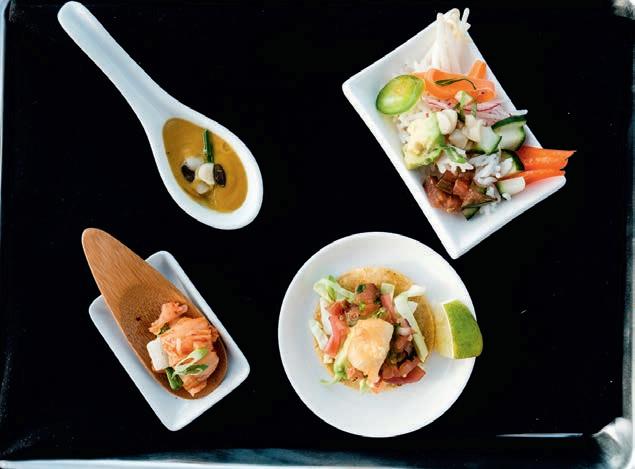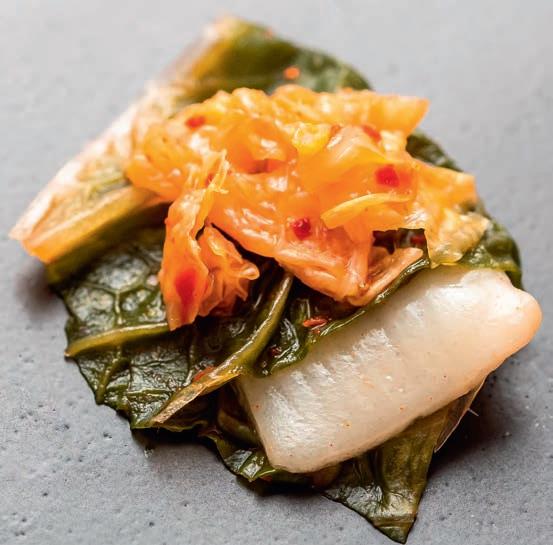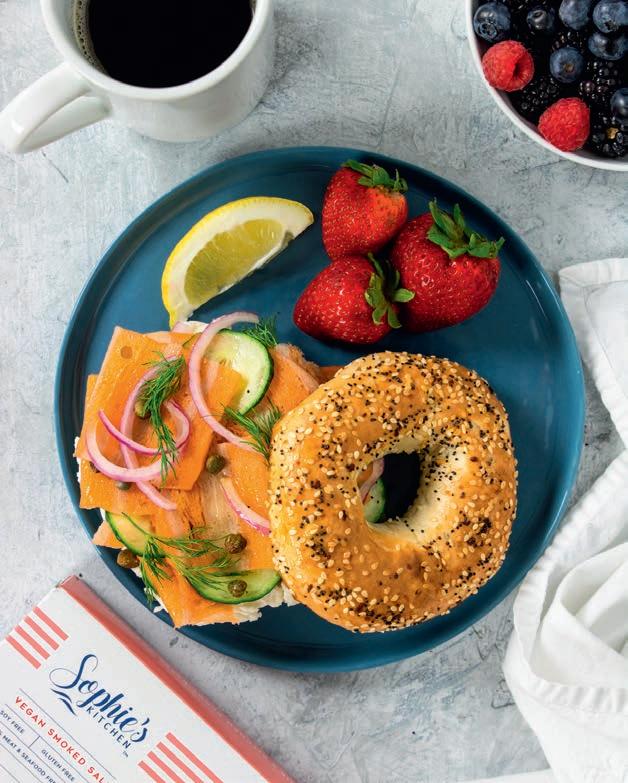
17 minute read
Sandy Neil


I can’t believe it’s not salmon!
Does ‘seafood’ grown in a lab or created from plant-based materials represent real competition for fi sh producers?
BY SANDY NEIL
When is “seafood” not actually seafood? This month, Fish Farmer explores the alterna� ves to wild-caught and farmed seafood, from plant-based vegan smoked “salmon” to lab-grown salmon sushi that has never been part of a living animal.
With global fi sheries under pressure as never before, can cultured cells provide fresh fi sh without tured cells provide fresh fi sh without the catch? And as interest in alterna� ve seafoods among consumers, brands and investors grows exponen� ally, with cellular agriculture projected to become mainstream in the next decade, should salmon farmers be worried?
“Last summer, we gathered with friends, chefs, journalists, and others at Olympia Oyster Bar in Portland, Oregon, to taste the world’s fi rst cellbased salmon,” vaunts the Californian start-up Wildtype, which has been working since 2016 to produce cultured salmon grown in a lab. The dinner was heralded as the largest tas� ng of labgrown meat, featuring a menu of ceviche verde, Hawaiian poke, and salmon tartare.
Wildtype’s pilot plant in San Francisco is on “a mission to create the cleanest, most sustainable fi sh on the planet, star� ng with salmon”, because oceans are being stressed by overfi shing. A single fi sh could provide food for thousands of people while leaving wild popula� ons untouched.
“We’ve now taken a second big step,” Wildtype announced this summer. “We couldn’t be more excited to unveil the next batch of Wildtype seafood: sushi-grade pacifi c salmon that’s perfect for sashimi, nigiri, or your favourite salmon roll.”
The product is “incredibly similar to conven� onal salmon with regard to fl avour, aroma, texture and degree of fa� ness,” said Wildtype co-founder Aryé Elfenbein. It can be baked, served as raw sashimi, and cold-smoked.
Just like the technology used to growing meat cells for burger or steak, food scien� sts are now making fi sh using stem cell biology and � ssue engineering. A researcher extracts a biopsy-sized sample of muscle � ssue from
cells for burger or steak, food scien� sts are now making fi sh using stem cell biology and � ssue engineering. A researcher extracts a biopsy-sized sample of muscle � ssue from an animal and isolates pluripotent stem cells, that is cells that are capable of giving rise to more than one diff erent type of cell. These mul� func� onal stem cells proliferate in a bioreactor stew for� fi ed with a proprietary mix of nutrients (sugars, salt, amino acids, vitamins). When the muscle cells have replicated to a large enough popula� on, they are gra� ed to form skeletal muscle-like popula� on, they are gra� ed to form skeletal muscle-like structures using techniques originally designed for medical structures using techniques originally designed for medical applica� ons.
“We start with cells from Pacifi c salmon and feed them the same nutrients that they would receive in the wild (sugars, fats, proteins, and minerals),” explains Wildtype’s other co-founder Jus� n Kolbeck. The salmon cells are fed the nutrient broth in stainless steel tanks, of the kind you might see in a microbrewery, before they are harvested and affi xed to plant-based structures, called “scaff olds”, to direct the cells’ growth. These help to create the moist, fl aky texture of a real fi sh fi llet.
“The result is real salmon, grown directly from cells, with the same nutri� onal profi le and taste as conven� onal salmon,” Kolbeck adds. “Our
Opposite: Wildtype sushi salmon Below: Wildtype sushi and packaging






hope is to eventually price Wildtype sushi-grade salmon to be competitive with conventional salmon in both restaurants and grocery.”
The company already has a waiting list for seafood fans, chefs and restaurateurs interested in its product.
From the cell stage to harvesting, it can take between three weeks to three months. Conventional fish farming can often take upwards of a year before the fish can be harvested. Should fish farmers be worried about alternative seafoods like cell-cultured salmon?
“While aquaculture provides an important alternative to the declining stocks of wild-caught fish, there are several challenges,” Kolbeck opines. Not least is the fact that a significant share of the feed used in aquaculture comes from wild-caught fish.
“As there is a finite limit to the number of fish we can sustainably pull from our oceans and rivers, aquaculture unfortunately does not solve our global scarcity challenges.” He says Wildtype’s cell-cultivated seafood is just one solution in an “all of the above” approach to sustainable seafood that includes more sustainable aquaculture practices and plant-based seafood.
“Until now, we have not had a seafood alternative that can substitute for wild-caught or farmed seafood,” says Elfenbein, Wildtype’s other co-founder. “Wildtype was founded on the notion that if we give people a delicious, nutritious alternative to conventionally produced seafood, there would no longer be a reason to continue placing undue strain on the biodiversity of our oceans and waterways.”
Fewer than 10 companies in the world are working on this kind of technology. Most are just a few years old, and only a handful of people have taste-tested their products. But already they are promising to have cell-cultured seafood on consumers’ plates within the decade. That is, in part, because developing a soft and flaky fish fillet is more straightforward than growing the tough muscle tissue of a beef steak, explains Lou Cooperhouse, president and chief executive of cell-cultured seafood company BlueNalu.
“Ultimately, it will be a simpler process to replicate the sensory characteristics of seafood versus red meat,” he said. “Red meat is, literally and figuratively, very tough.”
BlueNalu is hunting the holy grail of the cell-cultured fish industry: bluefin tuna. One of the most overfished species in the world, they are now so rare that prized specimens can sell for well over a million dollars. Growing bluefin tuna fillets on demand would transform its market, Mr Cooperhouse argues.
Earlier this year, BlueNalu raised $60m from its investors, and is building its first pilot production facility in San Diego, where it is based. Cooperhouse estimates the firm could be rolling out fillets of mahi-mahi, yellowtail, red snapper and bluefin tuna to customers in the UK within the decade.
“Fish derive omega-3s and other nutritional benefits from what they eat,” he says. “As a result, the cell-cultured seafood we produce will have the same nutritional profile as conventional seafood.”
In November 2020, Shiok Meats, the world’s first cell-based crustacean meat company based in Singapore, showcased the world’s first ever



cell-based lobster meat, served in lobster gazpacho and lobster terrine. It is hoping to commercialise its cell-based products, which include cell-based shrimp, crab, crayfi sh, next year.
Chief technology offi cer and co-founder Dr Ka Yi Lang said: “We are commi� ed to bringing this novel technology to the forefront of global food systems, so they are robust enough to feed 10 billion people by 2050.”
Avant Meats, based in Hong Kong, is taking a three-pronged approach. To capture the interest of poten� al Asian customers, it has developed cell-cultured fi sh maw, the swim bladder of a fi sh that is considered a delicacy in China. It has also developed a fi sh fi llet for Western markets, and cell-cultured fi sh collagen for use in skincare products.
Cell-based meats have developed quickly, but the products s� ll have a long way to go. The technology will need signifi cant advances for companies to eventually mass-produce fi llets resembling wild-caught seafood.
Making cell-based seafood is technically complicated and extremely expensive. Another cultured seafood company, Cultured Decadence, located in Wisconsin, USA, plans to make lobster meat. A� er a year in produc� on, they can make about half a gram from their reactors. They hope to increase output enough to provide public taste tests in the next 12 months. The cost of nourishing fi sh cells appears to be the biggest factor limi� ng expansion.
The concoc� on of salt, sugars, vitamins, and amino acids necessary for these cells to grow introduces a produc� on expense that these start-ups must overcome to achieve their desired scaleup. In 2019, one cell-based company produced a single salmon sushi roll for US$200 when the market value for wild-caught salmon at the � me was between $5-9 per kilogram.
“The current cost of produc� on is signifi cantly higher than the cost of conven� onal salmon,” admits WildType, “And the cul� vated seafood industry will certainly require a re-imagina� on of the underlying design and process of cell cul� va� on in order to bring costs in line with conven� onal seafood.”
Greg Murphy, BlueNalu’s Director of Corporate Development & Strategic Partnerships, said: “Today, seafood market pricing is based on supply, making it variable and unpredictable. A consumer is also paying for the parts of the fi sh that you don’t typically eat like heads, tails, skin, and bones. With BlueNalu seafood, our products will have 100% yield, and it is our goal to achieve price parity to conven� onal seafood products over � me, while providing a steady supply that is predictable, safe, and consistent to meet demand.”
While companies try to fi nd ways to reduce the expense, they are also concerned with whether they will be allowed to call their product “fi sh”. Producers argue that they have the right to call it meat. The US Federal Meat Inspec� on Act refers to meat as “any product… made wholly or in part from any meat or por� on of the carcass,” which seems to jus� fy the label.
In the UK, the Sco� sh Salmon Producers’ Associa� on (SSPO) disagrees: ‘It is both misleading and disingenuous to call foods ‘salmon’ or ‘seafood’ when they are clearly nothing of the sort. So our message to consumers is clear: if you want the benefi ts of a sustainably grown, healthy, nutri� ous seafood then buy Sco� sh salmon. Cell-cultured and plant-based alterna� ves claiming to be salmon are simply poor imita� ons of the real thing.’
Governing agencies worldwide are in the process of deciding how to regulate cellular agriculture. Unlike plant-based meat subs� tutes like Impossible Foods and Beyond Beef, which have skyrocketed in popularity in recent years, cell-based, lab-grown meat products have yet to be approved for mass consump� on in the US.
In Europe, cell-based products fall under the European Union Novel Food Regula� on. In December 2020, the Singapore government approved the sale of Eat Just’s lab-grown chicken, making it the fi rst country in the world to approve such meat consump� on on a commercial scale. The approval was expected to be a watershed for approvals from other countries, but that remains to be seen.
Studies are s� ll being performed on how cultured meats will impact the environment. A 2011 University of Oxford study indicated that cultured meats could generate 96% fewer greenhouse gas emissions than tradi� onal meat. But a later study by the same university suggested that depending on the produc� on and scale, lab-grown meats could lead to higher global temperatures in the long run due to some cultured meat produc� on methods requiring a large amount of energy.
“There is poten� al in cultured meat and cultured seafood, but it’s not the solu� on for these urgent problems we are facing now,” says Hanna






Clockwise from above: Wildtype sushi; BlueNalu’s yellowtail; BlueNalu yellowtail prepared four ways; Pacifi c bluefi n tuna




This page from top: Salmon; Wildtype sushi; BlueNalu beer ba� ered yellowtail Opposite: Sophie’s Kitchen Vegan Smoked Salmon Tuomisto, a specialist in the environmental impacts of food based at the University of Helsinki. “It will take quite long before these products will be available in supermarkets at a price that most people could aff ord. We cannot wait for cultured foods to solve the problems.”
Un� l the costs come down, cell-based seafood will have a diffi cult � me breaking into the market. And even then, research results indicate plant-based products could be more popular. Surveys gathered from consumers who received informa� on on the sustainability of conven� onal, plant-based, and cell-based meat led researchers to predict respec� ve market shares of 72%, 23%, and 5% for each. A market forecast by the US management consul� ng fi rm Kearney had a more posi� ve outlook for cell-based meat, and predicted that in the next 20 years the market share would be split about evenly between the three.
BlueNalu’s CEO Lou Cooperhouse says he is not looking to replace wildcaught or farm-raised seafood, but is aiming to become a third alterna� ve for vegan and vegetarian seafood eaters.
“Consumers are changing. They are looking at health. They are focused on the planet,” Cooperhouse said to NPR. “This is not a fad or a trend — this is happening.”
In consumer surveys, people say they take a product’s sustainability into account when making a purchase. This behaviour has increased by 10% during the pandemic, with consumers saying they are now more conscious of the environment. One of the sustainable shi� s many consumers are making is in their dietary choices, ea� ng vegan, for example, to circumvent prac� ces they perceive to be cruel to animals or unsustainable. If conserva� on does not win consumers over, cell-based seafood can certainly claim to be clean. Cells grown in a bioreactor would be free from the microplas� cs and chemical pollu� on now found in almost every wild-caught fi sh. That could be enough of an incen� ve for fi sh eaters to convert from conven� onal products. Cultured meat products will compete with conven� onally raised animals for consumer cash, but they will also face-off against the exis� ng plant-based market. Protein sources for plantbased products are rela� vely inexpensive; however, the post-harvest processing and formula� on advancements needed to duplicate the consumer experience of ea� ng meat can be rather pricey. Plant-based fats, fl avour enhancers, and colour addi� ves drive up the cost of these meat alterna� ves. S� ll, they are presently far more aff ordable than cell-based meats. Although cell-based meats have the advantage of texture and taste being iden� cal to the real thing, the plant-based market is far ahead in terms of establishing a consumer base.
Moreover, cell agriculture is not yet vegan. The Vegan Society acknowledges that “labgrown meat and fi sh have the poten� al to reduce animal suff ering and we understand that it has benefi ts to animal welfare but as an organisa� on we fi ght for an end to all exploita� on. As it currently stands the process of cul� vated meat and fi sh is not enough for us to support it.
“There is already a myriad of vegan seafood and fi sh alterna� ves that don’t derive from cul� vated or lab-grown fi sh – essen� ally there are kinder alterna� ves out there. Lab grown meat and fi sh is a great excuse to do nothing in the interim whilst wai� ng for an aff ordable and acceptable alterna� ve.”
“Cell culture is not without its challenges,” admits Wildtype: “There are s� ll some animal-based components used in much of the research across the industry and the brewery systems are s� ll quite energy intensive. But it’s very early days and we are confi dent that these issues will be mi� gated as the technology develops.”
Plant-based diets have evolved beyond tradi� onal vegetarian and vegan fare as more people choose to avoid animal protein. An April report for the Good Food Ins� tute states that total plant-based retail sales reached $7bn and grew 27% over the past year—almost double the growth rate in US retail food sales.
Many plant-based seafood companies are already vying for our plates. In June, UK food giant Birds Eye expanded its fast-growing plantbased Green Cuisine range with a fi rst-ever a� empt to create a vegan version of its fi sh fi ngers.
“Shoppers are increasingly looking for plantbased alterna� ves of their favourite foods,’ said Birds Eye senior marke� ng manager Jess Ali. The Green Cuisine brand was launched by Birds Eye in March 2019, and saw sales jump by 321% to £11.3m last year.
Last year US feed giant Cargill inves� ng in plant-based fi sh alterna� ves made by Dutch start-up Bfl ike, responding to fl exitarian consumers’ growing appe� te for plant-based products that deliver a “meat-like” experience’.
“Key to Bfl ike’s innova� on is its patent-pending vegan fat and blood pla� orms,” Cargill explains: “This ground-breaking technology results in plant-based meat and fi sh alterna� ve products that are virtually indis� nguishable from their animal-based counterparts, with similar visual



appearance (both raw and cooked), texture, mouthfeel, mel� ng behaviour and cooking performance.”
A new product called Veggie Marine Salmon, made by innova� ve French company Odontella, is made from microalgae and said to cook and taste just like salmon. According to the company, the Veggie Marine Salmon is rich in marine protein, carotenoids, and Omega-3, while at the same � me free from any pes� cides and heavy metals that are o� en found in fi sh.
Sophie’s Kitchen vegan smoked salmon slices meanwhile are a mix of water, olive oil, kanjac powder, pea starch, potato starch, pea protein, sea salt, organic agave nectar, seaweed powder, fenugreek, alginate (from seaweed), paprika, and calcium hydroxide.
In a bid to fi nd a sustainable alterna� ve to the 1.4 billion pounds of shrimp consumed in America every year, US-based New Wave Foods is using plants and seaweed to create shrimp’s texture and bite, and briny and sweet fl avours.
Whether plant-based or cell-cultured, the rise of alterna� ve seafood probably will not spell the end of aquaculture or fi shing on the open ocean. But it could off er diners the chance to enjoy a taste of the rarest species – or enjoy a fi sh dish every day of the week – without a side order of ethical and environmental guilt. FF

Introducing the new HYDROTECH VALUE SERIES

Smarter, stronger, more economical drum filters



More than 50 improvements
The way to become market leader in any industry is to give customers a quality product that fits their exact requirements at the best possible price. That is why we have developed the new Hydrotech Value series of drum filters. The Hydrotech Value drum filter series focuses on reduced maintenance, increased component quality and simplified operation – all to give your plant maximum filtration performance at a minimum operational cost.










